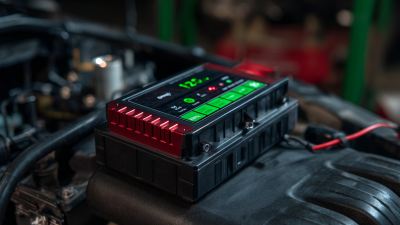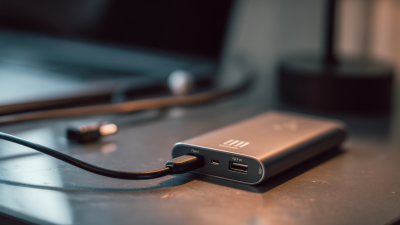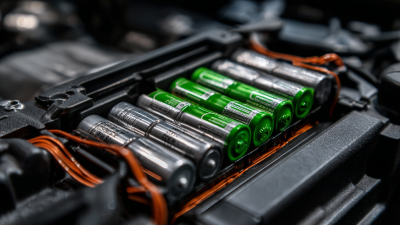The Future of Energy: How Ion Lithium Batteries are Revolutionizing Renewable Technologies
Table of Contents
- The Role of Ion Lithium Batteries in Enhancing Renewable Energy Storage
- Advantages of Ion Lithium Batteries Over Traditional Energy Storage Solutions
- Innovations in Ion Lithium Battery Technology and Their Impact on Renewable Energy
- Challenges Facing the Adoption of Ion Lithium Batteries in Renewable Systems
- The Future Landscape of Energy Storage: Ion Lithium Batteries and Emerging Alternatives
- Environmental Considerations for Ion Lithium Batteries in Renewable Energy Use
- FAQS
- Conclusion
- Related Posts
As the world transitions towards sustainable energy solutions, Ion Battery Lithium technology is at the forefront of revolutionizing renewable energy applications. With the global lithium-ion battery market projected to reach over $129 billion by 2027, driven by increasing demand for efficient energy storage systems, companies like Roofer Electronics Technology (Shanwei) Co., Ltd., with more than 27 years of expertise in R&D, manufacturing, and solution services, are poised to capitalize on this trend. Roofer's innovative battery products cater to a diverse range of applications, including household energy storage, electric bicycles, and power tools, thereby playing a pivotal role in reducing reliance on lead-acid batteries and enhancing energy efficiency across multiple sectors.

As the industry embraces cutting-edge technologies, the future of energy increasingly hinges on the advancements made possible by Ion Battery Lithium systems, which promise to deliver both efficiency and sustainability in our pursuit of a greener planet.
The Role of Ion Lithium Batteries in Enhancing Renewable Energy Storage
The integration of ion lithium batteries is a game changer for renewable energy storage, significantly enhancing the efficiency and reliability of solar, wind, and other renewable sources. According to a report by the International Renewable Energy Agency (IRENA), the global energy storage market is projected to grow to 1,095 GWh by 2030, with lithium-ion technology accounting for a substantial portion of this growth. This surge is driven by the need for scalable and flexible storage solutions that can accommodate the intermittent nature of renewable energy generation.
Furthermore, a study by BloombergNEF indicates that the cost of lithium-ion batteries has decreased by nearly 90% since 2010, making them an increasingly viable option for large-scale energy storage systems. This price drop is expected to continue, with projections suggesting that costs could fall to as low as $100 per kWh by 2025. The enhanced performance and affordability of ion lithium batteries are crucial for stabilizing power grids and maximizing the potential of renewable energy technologies, ultimately paving the way for a more sustainable and resilient energy landscape.
Advantages of Ion Lithium Batteries Over Traditional Energy Storage Solutions
The rise of ion lithium batteries marks a significant evolution in energy storage technologies, particularly in the realm of renewable energy systems. Unlike traditional batteries, ion lithium batteries offer higher energy density and faster charging capabilities, which are crucial for integrating renewable sources like solar and wind power into the grid. This advantage is evident as the residential lithium-ion battery storage market in the U.S. is projected to reach $1.52 billion by 2024, with expectations of substantial growth in the following years. As more homeowners install these systems, the demand for efficient energy storage continues to drive innovation.
Recent advancements in battery technology, such as improved ionic transport and the strength of silicon-carbon anodes, further enhance the performance of ion lithium batteries. With a compound annual growth rate (CAGR) of 14.36% forecasted leading into 2032, the market is primed for a transformative shift. The ability of these batteries to quickly capture and store energy when demand is low positions them as an essential component in achieving a sustainable energy future, outpacing traditional energy storage solutions. These developments not only promise to make renewable energy more accessible but also provide a robust infrastructure for energy management.

Innovations in Ion Lithium Battery Technology and Their Impact on Renewable Energy
Ion lithium batteries are at the forefront of innovations in renewable energy technology, transforming the landscape of energy storage and usage.
According to a report by the International Energy Agency (IEA), the demand for lithium-ion batteries is expected to skyrocket, with the market projected to grow from $41 billion in 2020 to over $100 billion by 2025. This exponential growth is primarily driven by the rising adoption of electric vehicles (EVs) and the increasing need for efficient energy storage solutions in renewable energy systems, such as solar and wind.
One of the significant advancements in ion lithium battery technology is the development of solid-state batteries, which promise higher energy density and improved safety. Research from the National Renewable Energy Laboratory (NREL) indicates that solid-state batteries can offer up to 50% more energy density compared to traditional lithium-ion batteries, thereby making renewable energy sources more viable by maximizing storage potential. Additionally, innovations like fast-charging capabilities and extended lifecycle will not only enhance user convenience but also play a crucial role in stabilizing and integrating renewable energy into the grid, providing a sustainable path towards a cleaner future.
Challenges Facing the Adoption of Ion Lithium Batteries in Renewable Systems
The adoption of ion lithium batteries in renewable energy systems faces several significant challenges. While the global lithium-ion battery market is projected to grow from $41 billion in 2020 to $94 billion by 2025, as reported by ResearchAndMarkets, the scalability and sustainability of lithium extraction have raised concerns among environmentalists. The pressure on lithium resources is intensifying, particularly with the anticipated rise in electric vehicle production, which could increase lithium demand by 60% over the next decade, according to the International Energy Agency (IEA).
Moreover, the recycling of lithium-ion batteries remains a critical issue. Currently, only about 5% of lithium batteries are recycled effectively, as indicated by a report from the World Economic Forum. This inefficiency contributes to both environmental waste and potential supply chain disruptions. Furthermore, the technology itself can be expensive; while costs have decreased significantly, the price per kilowatt-hour of lithium-ion batteries is still projected to be around $100, which may hinder affordability and widespread adoption in renewable systems. Addressing these challenges through innovative recycling methods and improving resource management practices will be essential for the successful integration of ion lithium batteries into the future of renewable energy technologies.
The Future Landscape of Energy Storage: Ion Lithium Batteries and Emerging Alternatives
The future of energy storage is undeniably tied to ion lithium batteries, which have become pivotal in optimizing renewable technologies. According to a report by the International Energy Agency, the demand for lithium batteries is expected to soar, projecting a growth rate of 20% per annum over the next decade. This surge is largely driven by the rising adoption of electric vehicles (EVs) and the increasing need for efficient energy storage solutions in households and industries. Roofer Electronics Technology (Shanwei) Co., Ltd., with its 27 years of expertise in R&D and manufacturing, has positioned itself at the forefront of this energy transition, providing advanced lithium battery solutions for various applications, including power tools, electric bicycles, and household energy systems.
As the industry evolves, alternatives to traditional lithium batteries are emerging. Solid-state batteries, for example, promise higher energy densities and enhanced safety, while cost-effective supercapacitors are gaining traction for specific applications. Nevertheless, ion lithium batteries remain the backbone of the current market, accounting for over 90% of rechargeable battery sales in the EV sector (2023 Battery Technology Market Report). Investing in advanced lithium battery technologies is vital for companies like Roofer, which not only caters to current market needs but also innovates toward a sustainable energy future.
Tips: Consider integrating lithium battery systems into your energy management strategy to maximize efficiency and reduce reliance on fossil fuels. Stay updated on new technologies emerging in the battery space to ensure you’re using state-of-the-art energy storage solutions for your applications.
Environmental Considerations for Ion Lithium Batteries in Renewable Energy Use
The environmental considerations surrounding lithium-ion batteries are increasingly critical as their role in renewable energy storage expands. While these batteries are essential for stabilizing the energy supplied by intermittent sources such as solar and wind, the mining practices for lithium and other essential materials pose significant environmental concerns. A recent report indicates that the demand for lithium-ion batteries is expected to grow sharply, driven by the renewable energy transition and the rising popularity of electric vehicles, which in turn stresses the importance of sustainable mining practices and supply chain resilience.

Furthermore, as the energy storage market continues to evolve, innovations in battery management systems are being developed to enhance the safety and efficiency of lithium-ion technology. Nonetheless, incidents of battery energy storage systems catching fire have raised alarms about their environmental impact, prompting regulatory bodies to issue guidelines aimed at mitigating risks associated with lithium-ion battery facilities in densely populated areas. As such, the industry must navigate these challenges while leveraging the rapid technological advancements to minimize ecological footprints and foster a cleaner, more sustainable energy future.
FAQS
: Ion lithium batteries offer higher energy density and faster charging capabilities, which are crucial for integrating renewable sources like solar and wind power into the grid.
The residential lithium-ion battery storage market in the U.S. is projected to reach $1.52 billion by 2024, with expectations of significant growth following that period.
Recent advancements include improved ionic transport and the enhanced strength of silicon-carbon anodes, which further boost the performance of ion lithium batteries.
The ion lithium battery market is expected to experience a compound annual growth rate (CAGR) of 14.36% leading into 2032.
Challenges include concerns over the scalability and sustainability of lithium extraction, along with difficulties in recycling these batteries effectively.
The demand for lithium is projected to increase by 60% over the next decade as electric vehicle production rises.
Only about 5% of lithium batteries are recycled effectively, contributing to environmental waste and potential supply chain disruptions.
The price per kilowatt-hour of lithium-ion batteries is projected to be around $100, which may hinder affordability and widespread adoption in renewable systems.
Addressing challenges through innovative recycling methods and improving resource management practices will be essential for successful integration.
By enabling rapid energy capture and storage when demand is low, ion lithium batteries are positioned as a vital component in the transition to sustainable energy solutions.
Conclusion
Ion Battery Lithium technology is at the forefront of transforming renewable energy storage solutions, offering significant advantages over traditional systems. By enhancing energy density, efficiency, and longevity, these batteries play a crucial role in maximizing the potential of renewable sources such as solar and wind power. Innovations in Ion Battery Lithium technology continue to drive advancements, but challenges remain, including cost, scalability, and environmental impact.
As Roofer Electronics Technology (Shanwei) Co., Ltd. demonstrates with over 27 years of expertise in lithium battery R&D and manufacturing, the future of energy storage is evolving rapidly. The growing adoption of Ion Battery Lithium could lead to a more sustainable energy landscape, paving the way for emerging alternatives while addressing environmental considerations in their deployment within renewable energy systems.
Related Posts
-

Exploring the Future: How Ion Battery Lithium Technology Powers Sustainable Energy Solutions
-

Understanding the Industry Standards for Best 12v Lithium Iron Battery Production
-

7 Unmatched Benefits of Lithium and Lithium Ion Batteries You Need to Know
-

What Are the Key Benefits of Using 12V Lithium Ion Batteries in Your Devices?
-

How to Choose the Right Lithium Battery for Your Specific Needs
-

How to Maximize Efficiency with Your Lithium Ion Battery Pack
Blog Tags:





 business@roofer.cn
business@roofer.cn +86 13502883088
+86 13502883088






